Status Operational Services 1 | Stations 5 | |
 | ||
Type Regional commuter railroad Daily ridership 1,800 (Q2 2016, weekday average) Operator Portland and Western Railroad Terminis Wilsonville Station (south), Beaverton Transit Center (north) | ||
WES Commuter Rail, or Westside Express Service, is a 14.7-mile (23.7 km) United States commuter rail line between Beaverton and Wilsonville, Oregon, in the Portland metropolitan area, mostly following busy Oregon Highway 217 and Interstate 5. The diesel-powered passenger rail service opened in February 2009 on upgraded existing freight rail tracks owned and operated by the Portland & Western Railroad (P&W). TriMet, the metropolitan area's regional transit agency, manages and funds the service, and it also owns and maintains the railcars and stations, but P&W staff operate the vehicles. In planning since the mid-1990s, the line has five stations: two in Beaverton, one in Tigard, one in Tualatin, and one in Wilsonville.
Contents
- An afternoon with trimet wes 9 13 16
- History
- Construction
- Delays and problems with Colorado Railcar
- Ridership
- Service
- Stations
- Equipment
- Future
- References
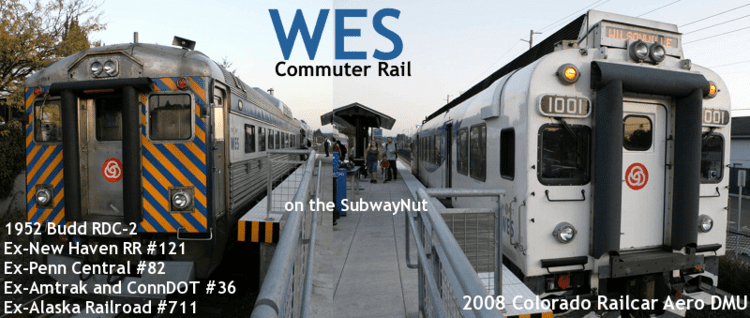
From the start of the first serious discussions of the idea, it took thirteen years and $166 million to get WES operational.

An afternoon with trimet wes 9 13 16
History
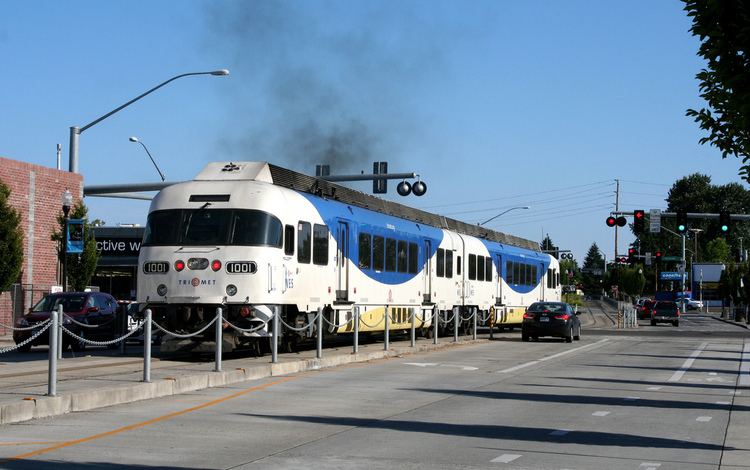
P&W’s freight line between Beaverton and Wilsonville was originally built by the Oregon Electric Railway (OE) Company. OE provided interurban passenger and freight service on electric rail lines linking Portland, Salem, and Eugene. By 1914, 26 trains using this line were entering and departing Portland every day. After the rise of the automobile, ridership diminished, and OE stopped offering passenger service in 1933. Passenger rail returned to Washington County in 1998 when the Tri-County Metropolitan Transportation District of Oregon (TriMet), which operates mass transportation systems in the region, began using an abandoned Burlington Northern railroad right-of-way between downtown Hillsboro and Beaverton for the light rail line known as Westside MAX. The right-of-way between the two towns was originally part of Oregon Electric's former Forest Grove line; portions of the line had carried BN freight trains as recently as 1994, before TriMet acquired it.
Construction
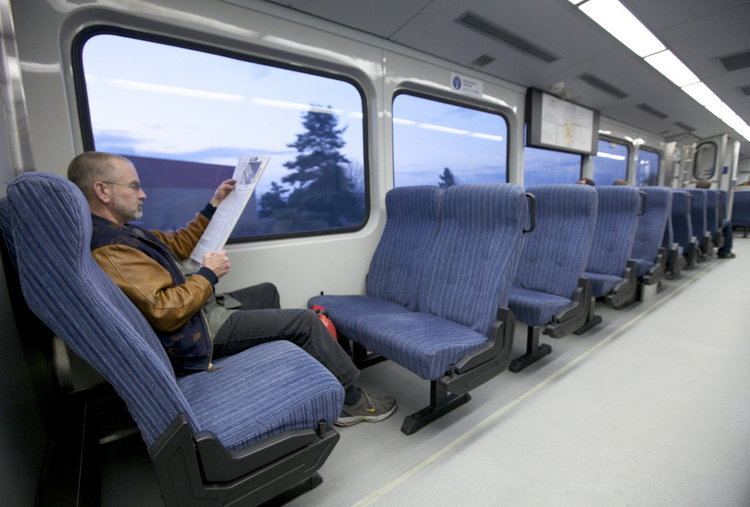
Led by Washington County, planning for WES began in 1996, when county officials started working with the cities of Beaverton, Tigard, Tualatin, Wilsonville and Sherwood, as well as government transportation agencies to study the idea of establishing passenger rail service between Beaverton and Wilsonville on the existing P&W line. TriMet took over as the project's lead planning agency in 2002. After years of delays due to lack of funding, the project received approval from the Federal Transit Administration in May 2004, resulting in the funding of approximately 50 percent of the line's capital costs. Track work began October 23, 2006, in Wilsonville, and a ceremonial "ground-breaking" was held two days later in Tigard, although the project had already started and no dirt was moved.

During planning and construction, the project was called the Washington County Commuter Rail, or alternately the Wilsonville to Beaverton Commuter Rail since much of Wilsonville is in Clackamas County. TriMet held a naming contest to choose a name for the new line, and in November 2007 it announced WES (Westside Express Service) as the winner. By December of that year, construction on the rail line was 75 percent complete and included five new bridges and two rehabilitated bridges, and improvements to 14 miles (23 km) of track and 14 road crossings. A distinctive feature of the line is the gauntlet track sections installed at the Hall-Nimbus, Tigard and Tualatin stations. The feature allows P&W freight trains to swing clear of the high-level platforms at the stops, so that wider cars do not strike them.
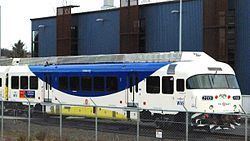
In June 2008, the line was more than 90 percent complete, with all the track in place. The four Colorado Railcar Diesel multiple unit (DMU) cars ordered for the line then arrived; a total of three powered DMU cars and one non-powered "trailer car" were tested on the route. A ceremonial inaugural run for dignitaries and journalists took place on January 22, and public preview rides on January 30, ahead of a February 2, 2009, public opening.
Delays and problems with Colorado Railcar
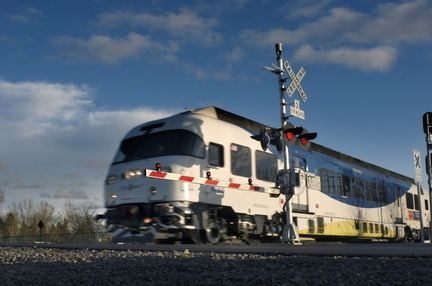
Originally scheduled to open in September 2008, opening was delayed several times and eventually to February 2009 due to technical and other difficulties, most notably the failure of Colorado Railcar (CR). TriMet lost $3 million from the delays and from its financial support of CR, which included paying CR's suppliers and providing "rail engineering expertise and on-site technical assistance." They provided bailout funds to CR, paying rent, phone, and power bills, and ultimately taking control of the failing company long enough to take delivery of its vehicles.
Ridership

Daily ridership has been lower than expected, averaging 1,260 in February 2010 compared with a pre-opening estimate of about 2,400 during the first year of operation and also a revised July 2009 prediction of 1,600 after one year. In TriMet Fiscal Year 2012 (July 2011– June 2012), WES averaged 1,639 rides per day.
Service
WES trains run every 30 minutes between Wilsonville and Beaverton during morning and afternoon rush hours. The scheduled one-way travel time is 27 minutes. For its first 3 1⁄2 years of service, the WES line was located entirely within TriMet fare zone 3, but travel on WES required a TriMet "All-Zone" (three-zone) fare, rather than a one-zone or two-zone fare. However, effective September 2012, TriMet discontinued all use of fare zones, and WES fares consequently became identical to the fares on any other TriMet rail or bus line. C-Tran all-zone day and monthly passes are also accepted as valid fare on WES. P&W, which continues to run freight trains on the line, operates the commuter trains, and TriMet maintains them.
Stations
The self-propelled rail cars on the 14.7-mile (23.7 km) line serve stations in Wilsonville, Tualatin, Tigard, and at two locations in Beaverton. At the Beaverton Transit Center, the northern terminus of the line, commuters using WES are able to transfer between the WES cars and either of two light-rail lines: the MAX Blue Line, serving the Hillsboro–Gresham corridor via downtown Portland, and the MAX Red Line, connecting to Portland International Airport via downtown Portland. The Beaverton Transit Center station also offers connections to 11 TriMet bus lines. Hall/Nimbus Station, the second stop in Beaverton, is served by local TriMet bus lines 76 and 78 and has about 50 park-and-ride spaces. The station is within walking distance of Washington Square Mall and Nimbus Business Park. The Beaverton Transit Center station has no park-and-ride facility.
Tigard Transit Center Station was an existing TriMet transit center and is served by six TriMet bus lines. Located in downtown Tigard, the station has about 100 park-and-ride spaces. Tualatin Station is in downtown Tualatin, on Boones Ferry Road near the intersection with Tualatin-Sherwood Road. The Tualatin station is served by TriMet bus line 76 and includes 130 park-and-ride spaces, plus another 24 spaces in a nearby lot connected to the station by line 76.
The Wilsonville station, at the southern end of the line, provides about 400 park-and-ride spaces. Wilsonville's South Metro Area Regional Transit (SMART) opened a new transit center, known as "SMART Central", at the station in January 2009. Wilsonville Station is connected via buses to residential and employment zones in the city. Wilsonville and Salem-Keizer Transit (Cherriots) currently provide express bus service between the two cities, linking to the rail line. The city of Canby to the southeast also links to WES through its Canby Area Transit service. Other neighboring communities are also expected to use the Wilsonville stop, including Lake Oswego, Donald, Woodburn, and Aurora.
Equipment
TriMet's fleet of commuter-rail cars consists of three powered cars and one "control trailer", a type of car which is unpowered but has an operating cab at one end and can control the powered car to which it is coupled. The trailer can be pulled or pushed. The self-propelled diesel cars do not require a locomotive or overhead electrical wires. Each of the three powered rail cars seat 74 passengers, while the unpowered car seats 80. The cars are numbered 1001–1003 (powered) and 2001 (trailer) in TriMet's fleet of vehicles. Originally priced at $4 million each prior to cost overruns, the cars are equipped with places for two mobility devices and two hanging bicycle racks, and have enough space for 139 standing passengers. In a two-car train, passengers can pass between the two connected cars. Interiors of both car types contain high-back seats with blue upholstery.
Trains on WES were designed to travel at an average speed of 37 miles per hour (60 km/h) with a top speed of 60 miles per hour (97 km/h). Each self-propelled car has two Detroit Diesel Series 60 12.7L engines, each of which is rated at 600 horsepower. TriMet was required to purchase U.S.-manufactured trains due to federal funding of the commuter line, and purchased from Colorado Railcar, the sole U.S. maker of DMUs that comply with Federal Railroad Administration (FRA) rules. The WES cars and the 35 freight locomotives sharing the track with WES include cab signals as part of a system designed to prevent train-to-train collisions. Positive train control is being installed along the line. Cars on the line are serviced and maintained by TriMet at the maintenance facility at the southern end of the line in Wilsonville. Adjacent to Wilsonville Station, the blue metal structure employs six mechanics. The adjacent rail yard is used to store all WES trains when not in service.
One piece of equipment replaced only a month after WES began operations is its train horn. The FRA requires all trains operating on heavy rail lines to sound their horns for at least 15 seconds at a minimum level of 96 decibels (from 100 feet) as they approach crossings. For the rush hour-only schedule used when WES began operation, that meant over a thousand blasts a week along its route, starting as early as 5:30 am. Complaints about the noise caused TriMet to replace the original 150-decibel Nathan horns with 75-decibel Leslie horns for a fleetwide cost $5,000. The new horns, which met the minimum requirements, still led to complaints. TriMet asked the FRA for a waiver, proposing that they install yet another horn — similar to that used on MAX Light Rail — that would sound at 80 decibels and be accompanied by bells that would ring at 60 decibels continuously as the train neared a crossing. However, the FRA turned down this request, citing safety concerns.
Equipment failures and periodic maintenance on the agency's Colorado Railcar DMUs resulted in TriMet substituting buses for some runs on several occasions since the service began. To provide backup equipment for the line, TriMet purchased two Budd Company Rail Diesel Cars (RDCs) from the Alaska Railroad in 2009. The cars were originally built in 1953, and had been taken out of service in 2008. TriMet refurbished the cars, and planned to operate them as a backup for the Colorado Railcar units when they are out of service. They entered service on January 24, 2011.
Future
Extension of the line farther south to Salem has been proposed. Station sites would include Salem, Keizer and Woodburn.
